Food Safety Management Report: Analysis of Adam's Restaurant - HND
VerifiedAdded on 2020/10/05
|15
|3565
|451
Report
AI Summary
This report provides a detailed analysis of food safety management within Adam's Restaurant, a fine-dining establishment in the UK. It begins by exploring various sources of food contamination and identifying control measures. The report then differentiates between food poisoning, food-borne infections, and food-borne illnesses, outlining their symptoms and control strategies. It categorizes food spoilage agents and examines effective food preservation methods, including their effectiveness. Furthermore, the report evaluates safe food storage methods, the significance of personal hygiene, cleaning, and pest control in preventing food contamination. Key steps in a temperature control system are outlined, along with the importance of hygienic design and construction of food premises. The report concludes by discussing the production of a food hazard risk assessment, the completion of a food safety control system, and the development of a food safety guide for legislation and compliance. The report includes information on the importance of training as a quality assurance mechanism.
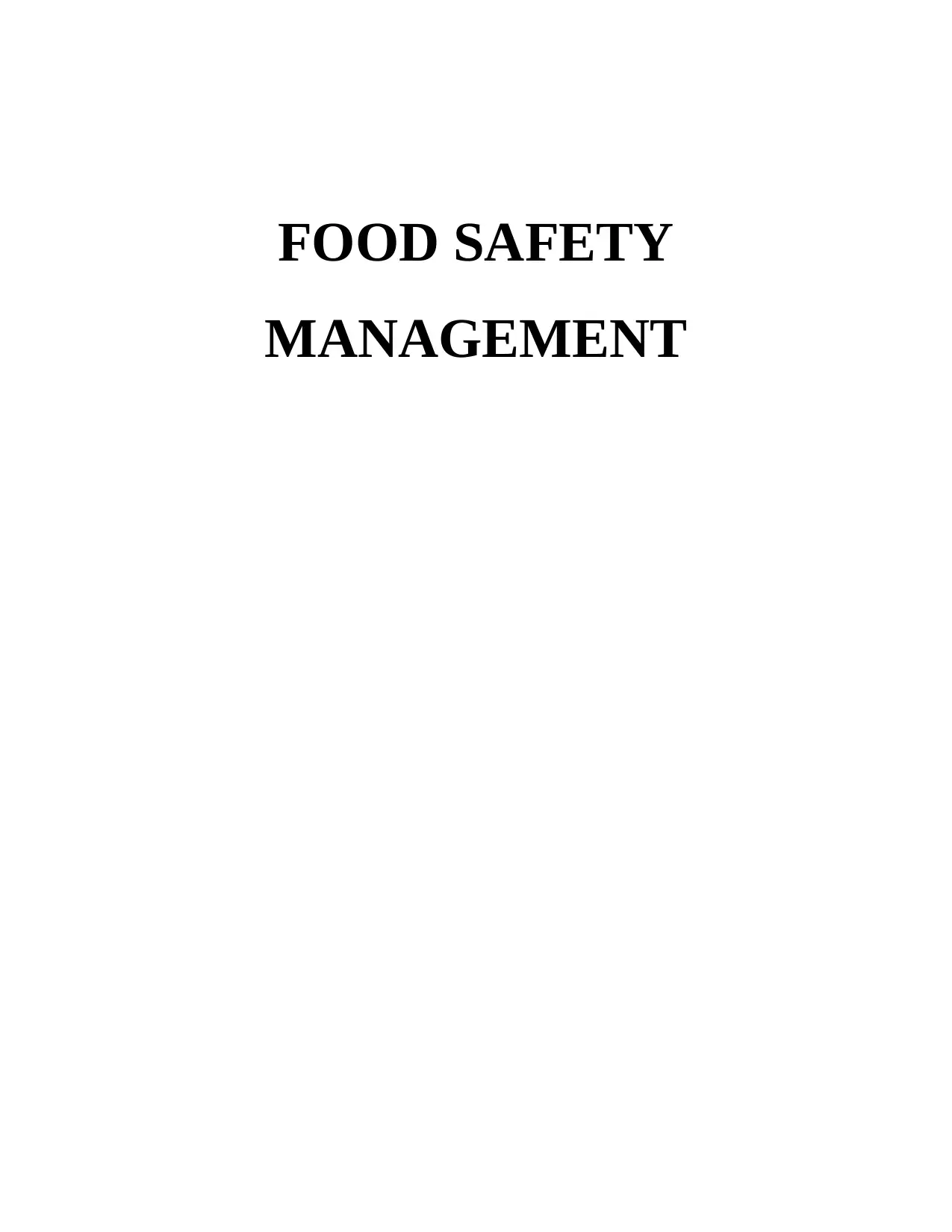
FOOD SAFETY
MANAGEMENT
MANAGEMENT
Paraphrase This Document
Need a fresh take? Get an instant paraphrase of this document with our AI Paraphraser
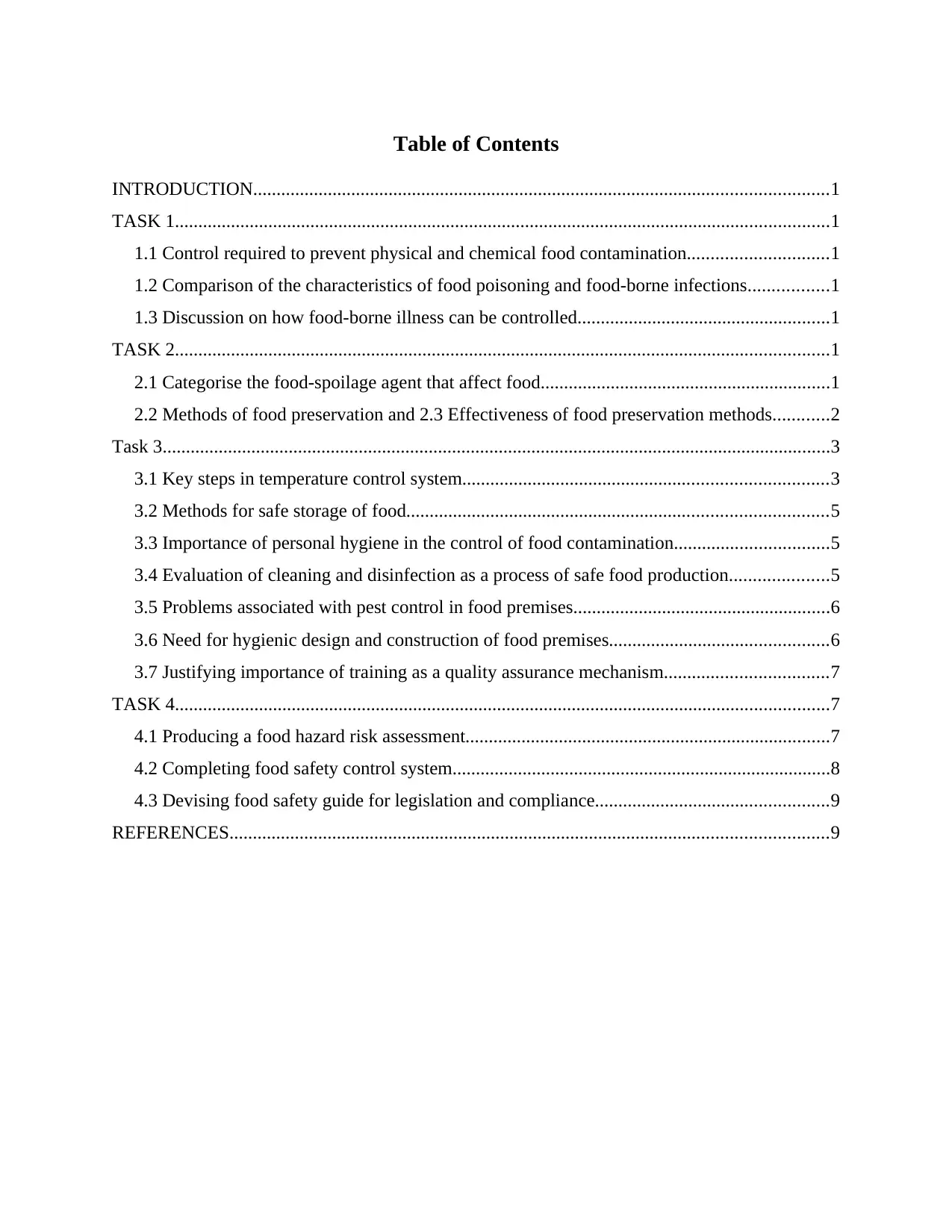
Table of Contents
INTRODUCTION...........................................................................................................................1
TASK 1............................................................................................................................................1
1.1 Control required to prevent physical and chemical food contamination..............................1
1.2 Comparison of the characteristics of food poisoning and food-borne infections.................1
1.3 Discussion on how food-borne illness can be controlled......................................................1
TASK 2............................................................................................................................................1
2.1 Categorise the food-spoilage agent that affect food..............................................................1
2.2 Methods of food preservation and 2.3 Effectiveness of food preservation methods............2
Task 3...............................................................................................................................................3
3.1 Key steps in temperature control system..............................................................................3
3.2 Methods for safe storage of food..........................................................................................5
3.3 Importance of personal hygiene in the control of food contamination.................................5
3.4 Evaluation of cleaning and disinfection as a process of safe food production.....................5
3.5 Problems associated with pest control in food premises.......................................................6
3.6 Need for hygienic design and construction of food premises...............................................6
3.7 Justifying importance of training as a quality assurance mechanism...................................7
TASK 4............................................................................................................................................7
4.1 Producing a food hazard risk assessment..............................................................................7
4.2 Completing food safety control system.................................................................................8
4.3 Devising food safety guide for legislation and compliance..................................................9
REFERENCES................................................................................................................................9
INTRODUCTION...........................................................................................................................1
TASK 1............................................................................................................................................1
1.1 Control required to prevent physical and chemical food contamination..............................1
1.2 Comparison of the characteristics of food poisoning and food-borne infections.................1
1.3 Discussion on how food-borne illness can be controlled......................................................1
TASK 2............................................................................................................................................1
2.1 Categorise the food-spoilage agent that affect food..............................................................1
2.2 Methods of food preservation and 2.3 Effectiveness of food preservation methods............2
Task 3...............................................................................................................................................3
3.1 Key steps in temperature control system..............................................................................3
3.2 Methods for safe storage of food..........................................................................................5
3.3 Importance of personal hygiene in the control of food contamination.................................5
3.4 Evaluation of cleaning and disinfection as a process of safe food production.....................5
3.5 Problems associated with pest control in food premises.......................................................6
3.6 Need for hygienic design and construction of food premises...............................................6
3.7 Justifying importance of training as a quality assurance mechanism...................................7
TASK 4............................................................................................................................................7
4.1 Producing a food hazard risk assessment..............................................................................7
4.2 Completing food safety control system.................................................................................8
4.3 Devising food safety guide for legislation and compliance..................................................9
REFERENCES................................................................................................................................9

⊘ This is a preview!⊘
Do you want full access?
Subscribe today to unlock all pages.

Trusted by 1+ million students worldwide
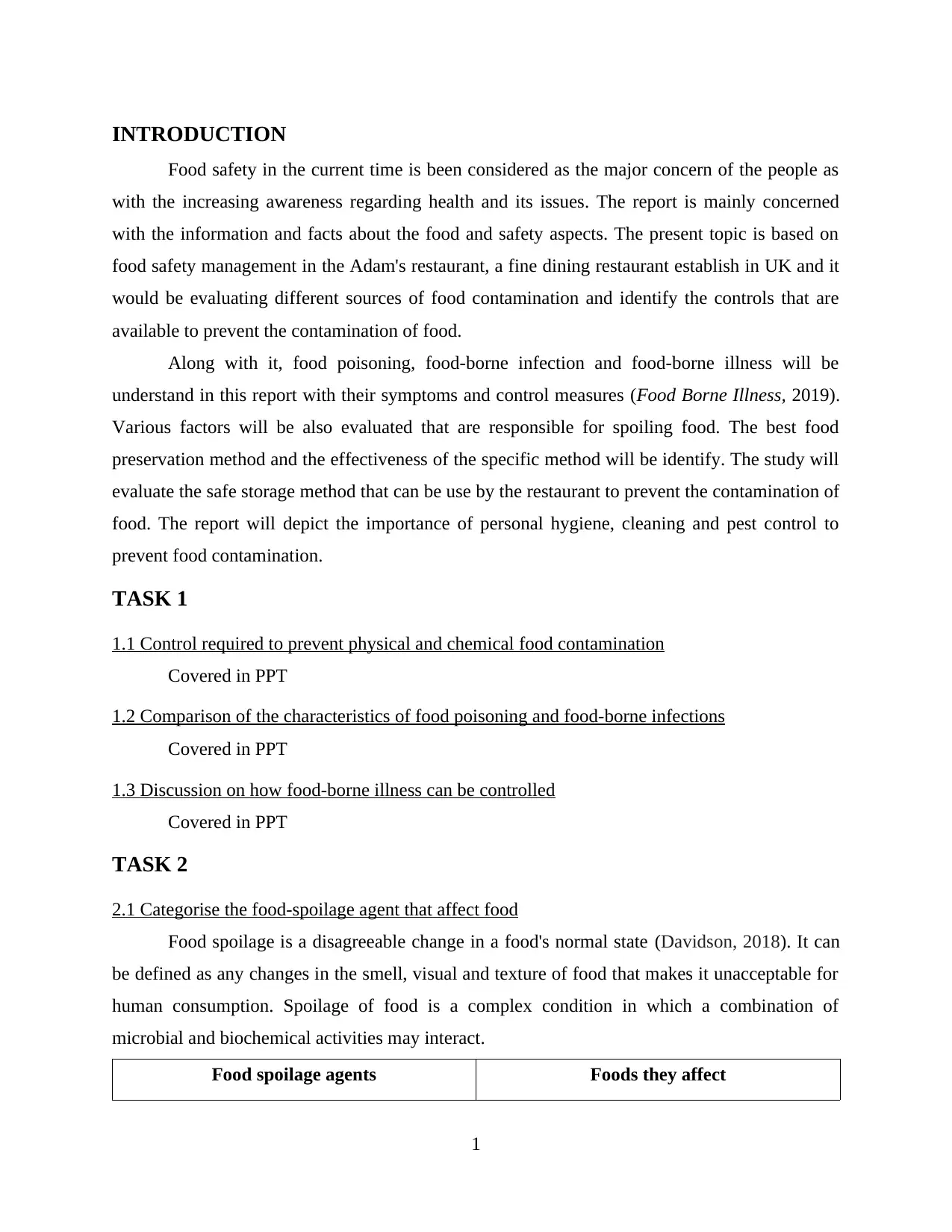
INTRODUCTION
Food safety in the current time is been considered as the major concern of the people as
with the increasing awareness regarding health and its issues. The report is mainly concerned
with the information and facts about the food and safety aspects. The present topic is based on
food safety management in the Adam's restaurant, a fine dining restaurant establish in UK and it
would be evaluating different sources of food contamination and identify the controls that are
available to prevent the contamination of food.
Along with it, food poisoning, food-borne infection and food-borne illness will be
understand in this report with their symptoms and control measures (Food Borne Illness, 2019).
Various factors will be also evaluated that are responsible for spoiling food. The best food
preservation method and the effectiveness of the specific method will be identify. The study will
evaluate the safe storage method that can be use by the restaurant to prevent the contamination of
food. The report will depict the importance of personal hygiene, cleaning and pest control to
prevent food contamination.
TASK 1
1.1 Control required to prevent physical and chemical food contamination
Covered in PPT
1.2 Comparison of the characteristics of food poisoning and food-borne infections
Covered in PPT
1.3 Discussion on how food-borne illness can be controlled
Covered in PPT
TASK 2
2.1 Categorise the food-spoilage agent that affect food
Food spoilage is a disagreeable change in a food's normal state (Davidson, 2018). It can
be defined as any changes in the smell, visual and texture of food that makes it unacceptable for
human consumption. Spoilage of food is a complex condition in which a combination of
microbial and biochemical activities may interact.
Food spoilage agents Foods they affect
1
Food safety in the current time is been considered as the major concern of the people as
with the increasing awareness regarding health and its issues. The report is mainly concerned
with the information and facts about the food and safety aspects. The present topic is based on
food safety management in the Adam's restaurant, a fine dining restaurant establish in UK and it
would be evaluating different sources of food contamination and identify the controls that are
available to prevent the contamination of food.
Along with it, food poisoning, food-borne infection and food-borne illness will be
understand in this report with their symptoms and control measures (Food Borne Illness, 2019).
Various factors will be also evaluated that are responsible for spoiling food. The best food
preservation method and the effectiveness of the specific method will be identify. The study will
evaluate the safe storage method that can be use by the restaurant to prevent the contamination of
food. The report will depict the importance of personal hygiene, cleaning and pest control to
prevent food contamination.
TASK 1
1.1 Control required to prevent physical and chemical food contamination
Covered in PPT
1.2 Comparison of the characteristics of food poisoning and food-borne infections
Covered in PPT
1.3 Discussion on how food-borne illness can be controlled
Covered in PPT
TASK 2
2.1 Categorise the food-spoilage agent that affect food
Food spoilage is a disagreeable change in a food's normal state (Davidson, 2018). It can
be defined as any changes in the smell, visual and texture of food that makes it unacceptable for
human consumption. Spoilage of food is a complex condition in which a combination of
microbial and biochemical activities may interact.
Food spoilage agents Foods they affect
1
Paraphrase This Document
Need a fresh take? Get an instant paraphrase of this document with our AI Paraphraser
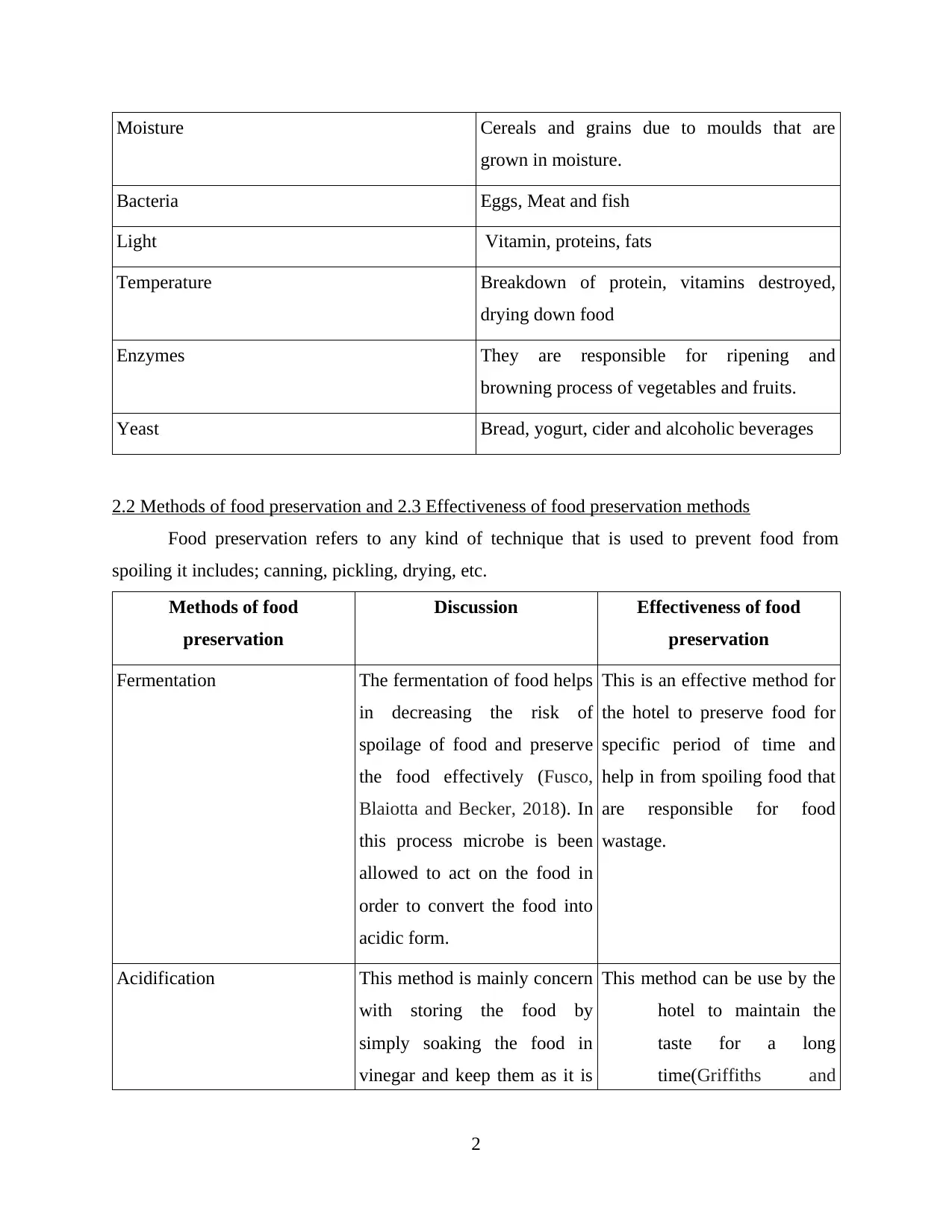
Moisture Cereals and grains due to moulds that are
grown in moisture.
Bacteria Eggs, Meat and fish
Light Vitamin, proteins, fats
Temperature Breakdown of protein, vitamins destroyed,
drying down food
Enzymes They are responsible for ripening and
browning process of vegetables and fruits.
Yeast Bread, yogurt, cider and alcoholic beverages
2.2 Methods of food preservation and 2.3 Effectiveness of food preservation methods
Food preservation refers to any kind of technique that is used to prevent food from
spoiling it includes; canning, pickling, drying, etc.
Methods of food
preservation
Discussion Effectiveness of food
preservation
Fermentation The fermentation of food helps
in decreasing the risk of
spoilage of food and preserve
the food effectively (Fusco,
Blaiotta and Becker, 2018). In
this process microbe is been
allowed to act on the food in
order to convert the food into
acidic form.
This is an effective method for
the hotel to preserve food for
specific period of time and
help in from spoiling food that
are responsible for food
wastage.
Acidification This method is mainly concern
with storing the food by
simply soaking the food in
vinegar and keep them as it is
This method can be use by the
hotel to maintain the
taste for a long
time(Griffiths and
2
grown in moisture.
Bacteria Eggs, Meat and fish
Light Vitamin, proteins, fats
Temperature Breakdown of protein, vitamins destroyed,
drying down food
Enzymes They are responsible for ripening and
browning process of vegetables and fruits.
Yeast Bread, yogurt, cider and alcoholic beverages
2.2 Methods of food preservation and 2.3 Effectiveness of food preservation methods
Food preservation refers to any kind of technique that is used to prevent food from
spoiling it includes; canning, pickling, drying, etc.
Methods of food
preservation
Discussion Effectiveness of food
preservation
Fermentation The fermentation of food helps
in decreasing the risk of
spoilage of food and preserve
the food effectively (Fusco,
Blaiotta and Becker, 2018). In
this process microbe is been
allowed to act on the food in
order to convert the food into
acidic form.
This is an effective method for
the hotel to preserve food for
specific period of time and
help in from spoiling food that
are responsible for food
wastage.
Acidification This method is mainly concern
with storing the food by
simply soaking the food in
vinegar and keep them as it is
This method can be use by the
hotel to maintain the
taste for a long
time(Griffiths and
2
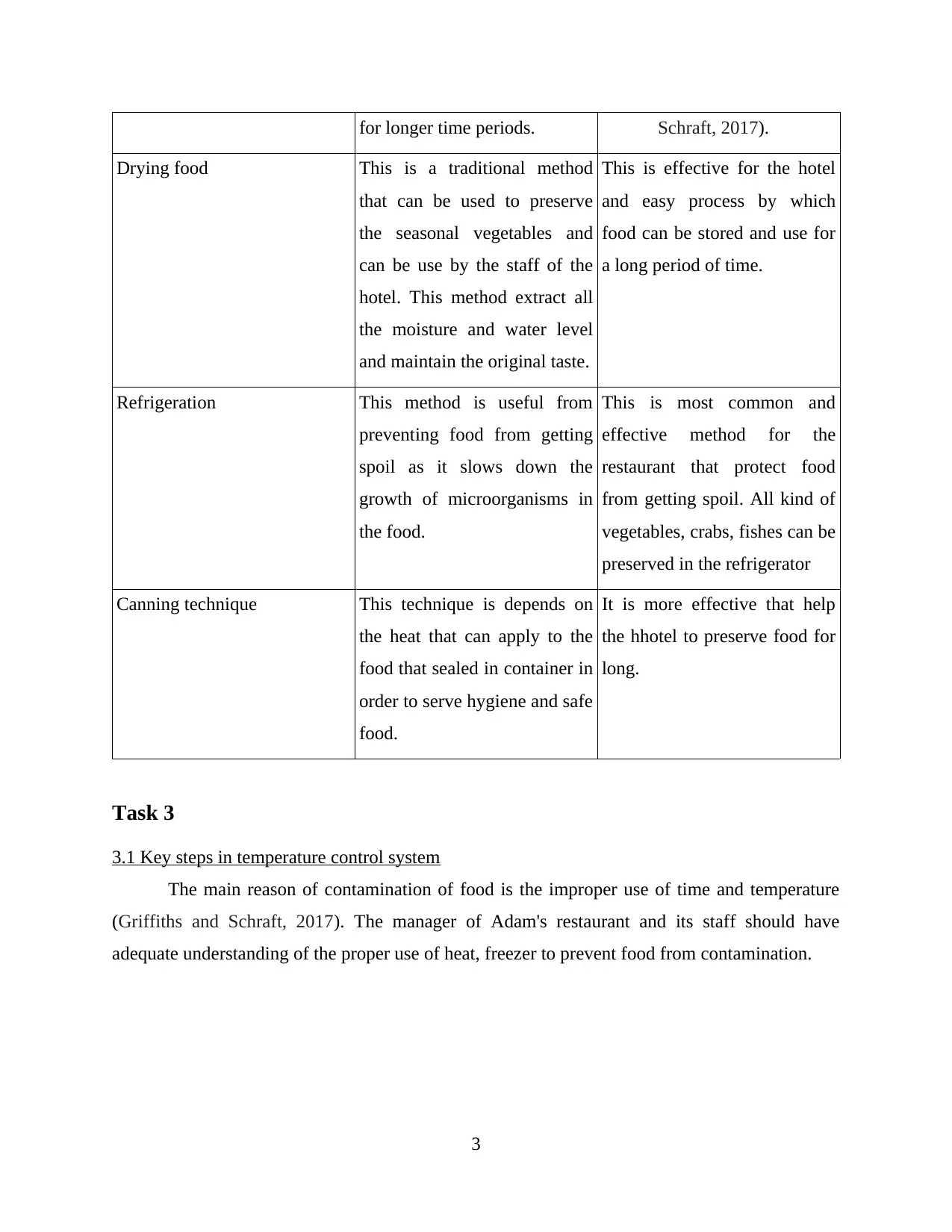
for longer time periods. Schraft, 2017).
Drying food This is a traditional method
that can be used to preserve
the seasonal vegetables and
can be use by the staff of the
hotel. This method extract all
the moisture and water level
and maintain the original taste.
This is effective for the hotel
and easy process by which
food can be stored and use for
a long period of time.
Refrigeration This method is useful from
preventing food from getting
spoil as it slows down the
growth of microorganisms in
the food.
This is most common and
effective method for the
restaurant that protect food
from getting spoil. All kind of
vegetables, crabs, fishes can be
preserved in the refrigerator
Canning technique This technique is depends on
the heat that can apply to the
food that sealed in container in
order to serve hygiene and safe
food.
It is more effective that help
the hhotel to preserve food for
long.
Task 3
3.1 Key steps in temperature control system
The main reason of contamination of food is the improper use of time and temperature
(Griffiths and Schraft, 2017). The manager of Adam's restaurant and its staff should have
adequate understanding of the proper use of heat, freezer to prevent food from contamination.
3
Drying food This is a traditional method
that can be used to preserve
the seasonal vegetables and
can be use by the staff of the
hotel. This method extract all
the moisture and water level
and maintain the original taste.
This is effective for the hotel
and easy process by which
food can be stored and use for
a long period of time.
Refrigeration This method is useful from
preventing food from getting
spoil as it slows down the
growth of microorganisms in
the food.
This is most common and
effective method for the
restaurant that protect food
from getting spoil. All kind of
vegetables, crabs, fishes can be
preserved in the refrigerator
Canning technique This technique is depends on
the heat that can apply to the
food that sealed in container in
order to serve hygiene and safe
food.
It is more effective that help
the hhotel to preserve food for
long.
Task 3
3.1 Key steps in temperature control system
The main reason of contamination of food is the improper use of time and temperature
(Griffiths and Schraft, 2017). The manager of Adam's restaurant and its staff should have
adequate understanding of the proper use of heat, freezer to prevent food from contamination.
3
⊘ This is a preview!⊘
Do you want full access?
Subscribe today to unlock all pages.

Trusted by 1+ million students worldwide
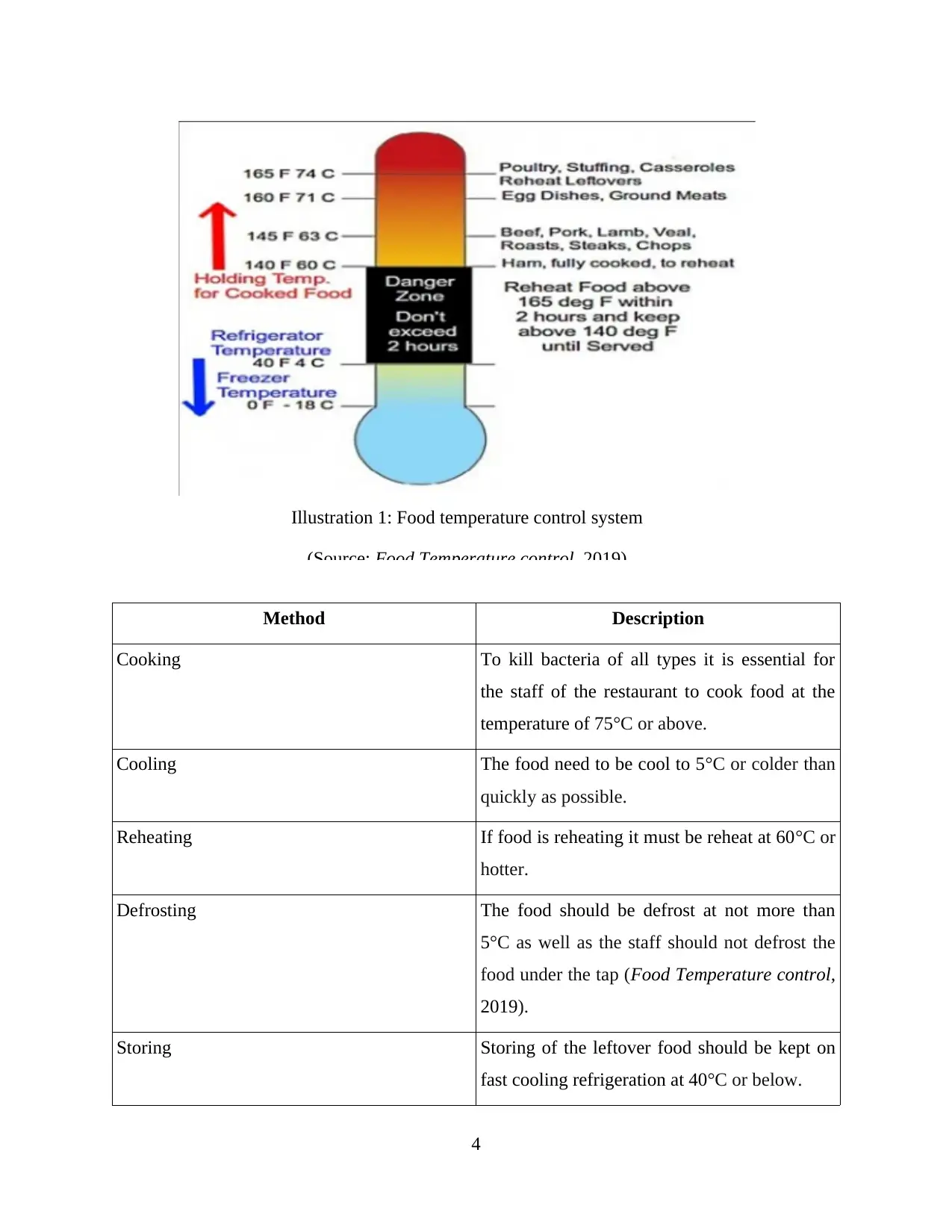
Method Description
Cooking To kill bacteria of all types it is essential for
the staff of the restaurant to cook food at the
temperature of 75°C or above.
Cooling The food need to be cool to 5°C or colder than
quickly as possible.
Reheating If food is reheating it must be reheat at 60°C or
hotter.
Defrosting The food should be defrost at not more than
5°C as well as the staff should not defrost the
food under the tap (Food Temperature control,
2019).
Storing Storing of the leftover food should be kept on
fast cooling refrigeration at 40°C or below.
4
Illustration 1: Food temperature control system
(Source: Food Temperature control, 2019)
Cooking To kill bacteria of all types it is essential for
the staff of the restaurant to cook food at the
temperature of 75°C or above.
Cooling The food need to be cool to 5°C or colder than
quickly as possible.
Reheating If food is reheating it must be reheat at 60°C or
hotter.
Defrosting The food should be defrost at not more than
5°C as well as the staff should not defrost the
food under the tap (Food Temperature control,
2019).
Storing Storing of the leftover food should be kept on
fast cooling refrigeration at 40°C or below.
4
Illustration 1: Food temperature control system
(Source: Food Temperature control, 2019)
Paraphrase This Document
Need a fresh take? Get an instant paraphrase of this document with our AI Paraphraser
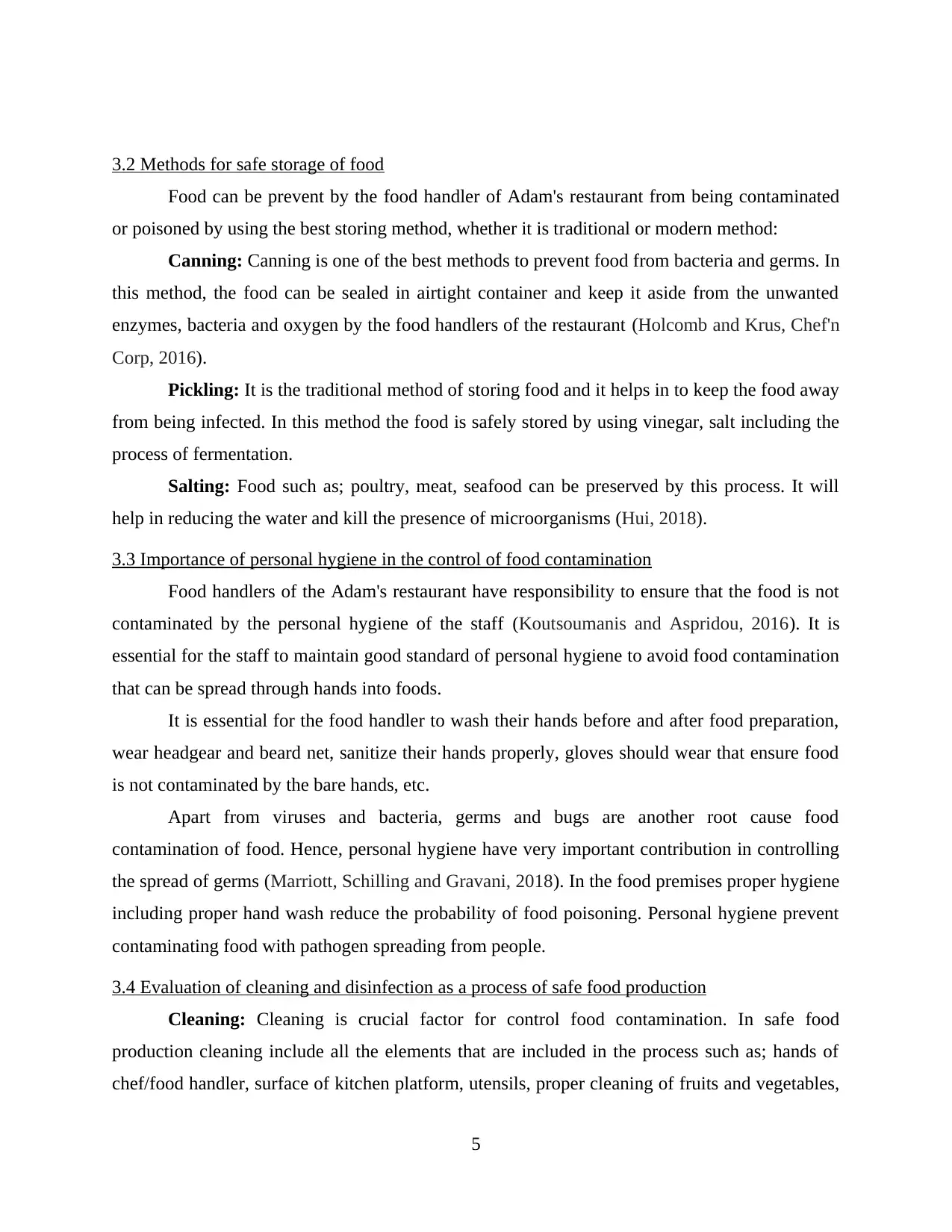
3.2 Methods for safe storage of food
Food can be prevent by the food handler of Adam's restaurant from being contaminated
or poisoned by using the best storing method, whether it is traditional or modern method:
Canning: Canning is one of the best methods to prevent food from bacteria and germs. In
this method, the food can be sealed in airtight container and keep it aside from the unwanted
enzymes, bacteria and oxygen by the food handlers of the restaurant (Holcomb and Krus, Chef'n
Corp, 2016).
Pickling: It is the traditional method of storing food and it helps in to keep the food away
from being infected. In this method the food is safely stored by using vinegar, salt including the
process of fermentation.
Salting: Food such as; poultry, meat, seafood can be preserved by this process. It will
help in reducing the water and kill the presence of microorganisms (Hui, 2018).
3.3 Importance of personal hygiene in the control of food contamination
Food handlers of the Adam's restaurant have responsibility to ensure that the food is not
contaminated by the personal hygiene of the staff (Koutsoumanis and Aspridou, 2016). It is
essential for the staff to maintain good standard of personal hygiene to avoid food contamination
that can be spread through hands into foods.
It is essential for the food handler to wash their hands before and after food preparation,
wear headgear and beard net, sanitize their hands properly, gloves should wear that ensure food
is not contaminated by the bare hands, etc.
Apart from viruses and bacteria, germs and bugs are another root cause food
contamination of food. Hence, personal hygiene have very important contribution in controlling
the spread of germs (Marriott, Schilling and Gravani, 2018). In the food premises proper hygiene
including proper hand wash reduce the probability of food poisoning. Personal hygiene prevent
contaminating food with pathogen spreading from people.
3.4 Evaluation of cleaning and disinfection as a process of safe food production
Cleaning: Cleaning is crucial factor for control food contamination. In safe food
production cleaning include all the elements that are included in the process such as; hands of
chef/food handler, surface of kitchen platform, utensils, proper cleaning of fruits and vegetables,
5
Food can be prevent by the food handler of Adam's restaurant from being contaminated
or poisoned by using the best storing method, whether it is traditional or modern method:
Canning: Canning is one of the best methods to prevent food from bacteria and germs. In
this method, the food can be sealed in airtight container and keep it aside from the unwanted
enzymes, bacteria and oxygen by the food handlers of the restaurant (Holcomb and Krus, Chef'n
Corp, 2016).
Pickling: It is the traditional method of storing food and it helps in to keep the food away
from being infected. In this method the food is safely stored by using vinegar, salt including the
process of fermentation.
Salting: Food such as; poultry, meat, seafood can be preserved by this process. It will
help in reducing the water and kill the presence of microorganisms (Hui, 2018).
3.3 Importance of personal hygiene in the control of food contamination
Food handlers of the Adam's restaurant have responsibility to ensure that the food is not
contaminated by the personal hygiene of the staff (Koutsoumanis and Aspridou, 2016). It is
essential for the staff to maintain good standard of personal hygiene to avoid food contamination
that can be spread through hands into foods.
It is essential for the food handler to wash their hands before and after food preparation,
wear headgear and beard net, sanitize their hands properly, gloves should wear that ensure food
is not contaminated by the bare hands, etc.
Apart from viruses and bacteria, germs and bugs are another root cause food
contamination of food. Hence, personal hygiene have very important contribution in controlling
the spread of germs (Marriott, Schilling and Gravani, 2018). In the food premises proper hygiene
including proper hand wash reduce the probability of food poisoning. Personal hygiene prevent
contaminating food with pathogen spreading from people.
3.4 Evaluation of cleaning and disinfection as a process of safe food production
Cleaning: Cleaning is crucial factor for control food contamination. In safe food
production cleaning include all the elements that are included in the process such as; hands of
chef/food handler, surface of kitchen platform, utensils, proper cleaning of fruits and vegetables,
5
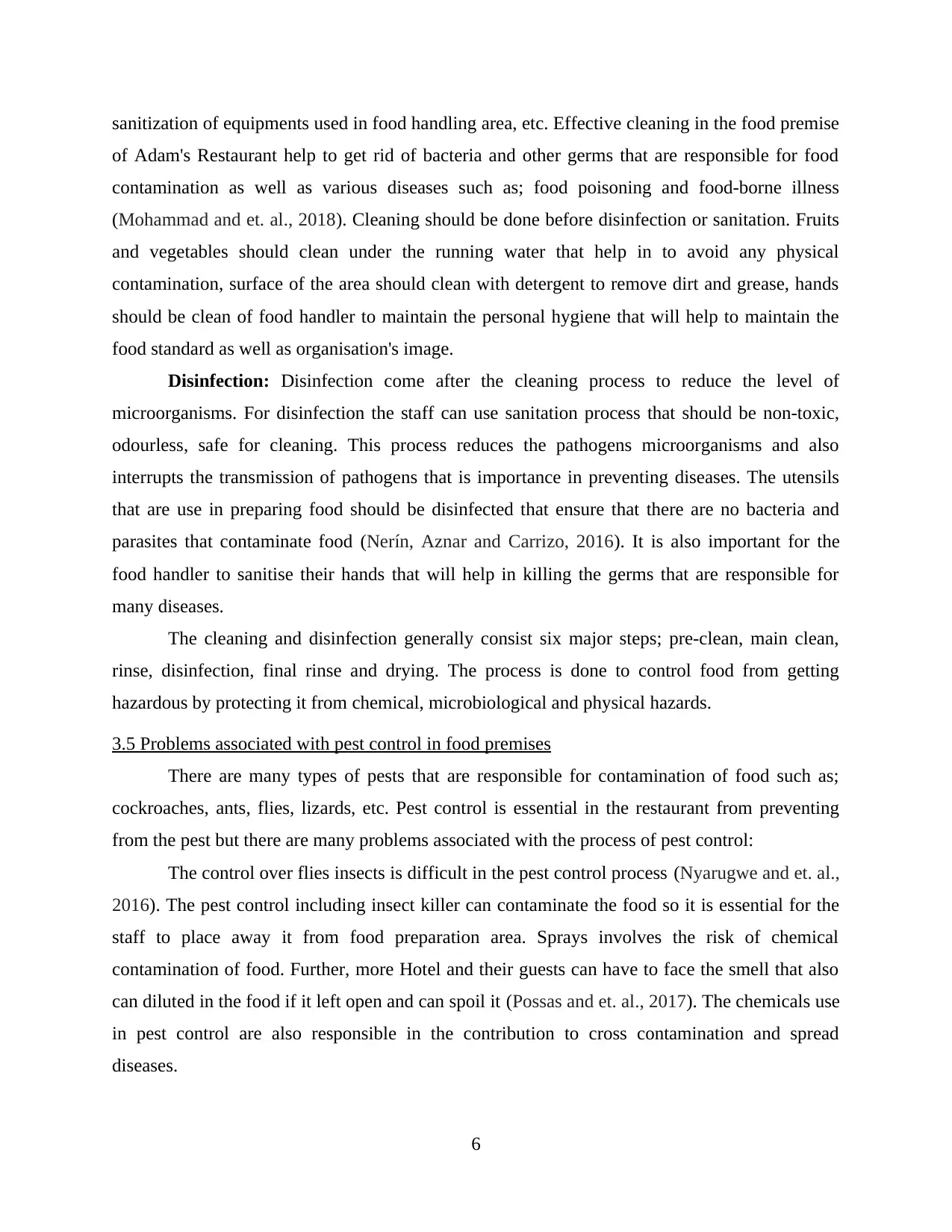
sanitization of equipments used in food handling area, etc. Effective cleaning in the food premise
of Adam's Restaurant help to get rid of bacteria and other germs that are responsible for food
contamination as well as various diseases such as; food poisoning and food-borne illness
(Mohammad and et. al., 2018). Cleaning should be done before disinfection or sanitation. Fruits
and vegetables should clean under the running water that help in to avoid any physical
contamination, surface of the area should clean with detergent to remove dirt and grease, hands
should be clean of food handler to maintain the personal hygiene that will help to maintain the
food standard as well as organisation's image.
Disinfection: Disinfection come after the cleaning process to reduce the level of
microorganisms. For disinfection the staff can use sanitation process that should be non-toxic,
odourless, safe for cleaning. This process reduces the pathogens microorganisms and also
interrupts the transmission of pathogens that is importance in preventing diseases. The utensils
that are use in preparing food should be disinfected that ensure that there are no bacteria and
parasites that contaminate food (Nerín, Aznar and Carrizo, 2016). It is also important for the
food handler to sanitise their hands that will help in killing the germs that are responsible for
many diseases.
The cleaning and disinfection generally consist six major steps; pre-clean, main clean,
rinse, disinfection, final rinse and drying. The process is done to control food from getting
hazardous by protecting it from chemical, microbiological and physical hazards.
3.5 Problems associated with pest control in food premises
There are many types of pests that are responsible for contamination of food such as;
cockroaches, ants, flies, lizards, etc. Pest control is essential in the restaurant from preventing
from the pest but there are many problems associated with the process of pest control:
The control over flies insects is difficult in the pest control process (Nyarugwe and et. al.,
2016). The pest control including insect killer can contaminate the food so it is essential for the
staff to place away it from food preparation area. Sprays involves the risk of chemical
contamination of food. Further, more Hotel and their guests can have to face the smell that also
can diluted in the food if it left open and can spoil it (Possas and et. al., 2017). The chemicals use
in pest control are also responsible in the contribution to cross contamination and spread
diseases.
6
of Adam's Restaurant help to get rid of bacteria and other germs that are responsible for food
contamination as well as various diseases such as; food poisoning and food-borne illness
(Mohammad and et. al., 2018). Cleaning should be done before disinfection or sanitation. Fruits
and vegetables should clean under the running water that help in to avoid any physical
contamination, surface of the area should clean with detergent to remove dirt and grease, hands
should be clean of food handler to maintain the personal hygiene that will help to maintain the
food standard as well as organisation's image.
Disinfection: Disinfection come after the cleaning process to reduce the level of
microorganisms. For disinfection the staff can use sanitation process that should be non-toxic,
odourless, safe for cleaning. This process reduces the pathogens microorganisms and also
interrupts the transmission of pathogens that is importance in preventing diseases. The utensils
that are use in preparing food should be disinfected that ensure that there are no bacteria and
parasites that contaminate food (Nerín, Aznar and Carrizo, 2016). It is also important for the
food handler to sanitise their hands that will help in killing the germs that are responsible for
many diseases.
The cleaning and disinfection generally consist six major steps; pre-clean, main clean,
rinse, disinfection, final rinse and drying. The process is done to control food from getting
hazardous by protecting it from chemical, microbiological and physical hazards.
3.5 Problems associated with pest control in food premises
There are many types of pests that are responsible for contamination of food such as;
cockroaches, ants, flies, lizards, etc. Pest control is essential in the restaurant from preventing
from the pest but there are many problems associated with the process of pest control:
The control over flies insects is difficult in the pest control process (Nyarugwe and et. al.,
2016). The pest control including insect killer can contaminate the food so it is essential for the
staff to place away it from food preparation area. Sprays involves the risk of chemical
contamination of food. Further, more Hotel and their guests can have to face the smell that also
can diluted in the food if it left open and can spoil it (Possas and et. al., 2017). The chemicals use
in pest control are also responsible in the contribution to cross contamination and spread
diseases.
6
⊘ This is a preview!⊘
Do you want full access?
Subscribe today to unlock all pages.

Trusted by 1+ million students worldwide
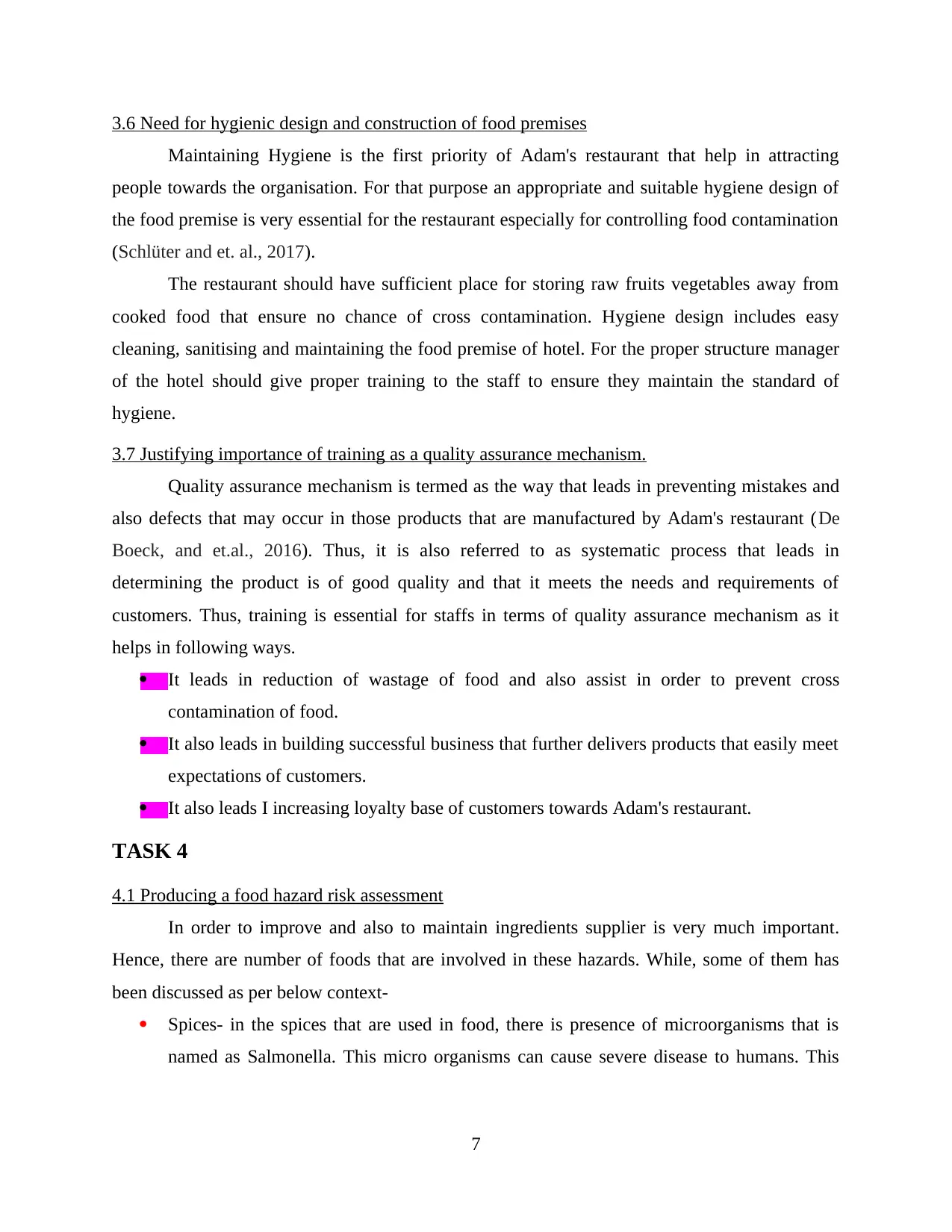
3.6 Need for hygienic design and construction of food premises
Maintaining Hygiene is the first priority of Adam's restaurant that help in attracting
people towards the organisation. For that purpose an appropriate and suitable hygiene design of
the food premise is very essential for the restaurant especially for controlling food contamination
(Schlüter and et. al., 2017).
The restaurant should have sufficient place for storing raw fruits vegetables away from
cooked food that ensure no chance of cross contamination. Hygiene design includes easy
cleaning, sanitising and maintaining the food premise of hotel. For the proper structure manager
of the hotel should give proper training to the staff to ensure they maintain the standard of
hygiene.
3.7 Justifying importance of training as a quality assurance mechanism.
Quality assurance mechanism is termed as the way that leads in preventing mistakes and
also defects that may occur in those products that are manufactured by Adam's restaurant (De
Boeck, and et.al., 2016). Thus, it is also referred to as systematic process that leads in
determining the product is of good quality and that it meets the needs and requirements of
customers. Thus, training is essential for staffs in terms of quality assurance mechanism as it
helps in following ways.
It leads in reduction of wastage of food and also assist in order to prevent cross
contamination of food.
It also leads in building successful business that further delivers products that easily meet
expectations of customers.
It also leads I increasing loyalty base of customers towards Adam's restaurant.
TASK 4
4.1 Producing a food hazard risk assessment
In order to improve and also to maintain ingredients supplier is very much important.
Hence, there are number of foods that are involved in these hazards. While, some of them has
been discussed as per below context-
Spices- in the spices that are used in food, there is presence of microorganisms that is
named as Salmonella. This micro organisms can cause severe disease to humans. This
7
Maintaining Hygiene is the first priority of Adam's restaurant that help in attracting
people towards the organisation. For that purpose an appropriate and suitable hygiene design of
the food premise is very essential for the restaurant especially for controlling food contamination
(Schlüter and et. al., 2017).
The restaurant should have sufficient place for storing raw fruits vegetables away from
cooked food that ensure no chance of cross contamination. Hygiene design includes easy
cleaning, sanitising and maintaining the food premise of hotel. For the proper structure manager
of the hotel should give proper training to the staff to ensure they maintain the standard of
hygiene.
3.7 Justifying importance of training as a quality assurance mechanism.
Quality assurance mechanism is termed as the way that leads in preventing mistakes and
also defects that may occur in those products that are manufactured by Adam's restaurant (De
Boeck, and et.al., 2016). Thus, it is also referred to as systematic process that leads in
determining the product is of good quality and that it meets the needs and requirements of
customers. Thus, training is essential for staffs in terms of quality assurance mechanism as it
helps in following ways.
It leads in reduction of wastage of food and also assist in order to prevent cross
contamination of food.
It also leads in building successful business that further delivers products that easily meet
expectations of customers.
It also leads I increasing loyalty base of customers towards Adam's restaurant.
TASK 4
4.1 Producing a food hazard risk assessment
In order to improve and also to maintain ingredients supplier is very much important.
Hence, there are number of foods that are involved in these hazards. While, some of them has
been discussed as per below context-
Spices- in the spices that are used in food, there is presence of microorganisms that is
named as Salmonella. This micro organisms can cause severe disease to humans. This
7
Paraphrase This Document
Need a fresh take? Get an instant paraphrase of this document with our AI Paraphraser
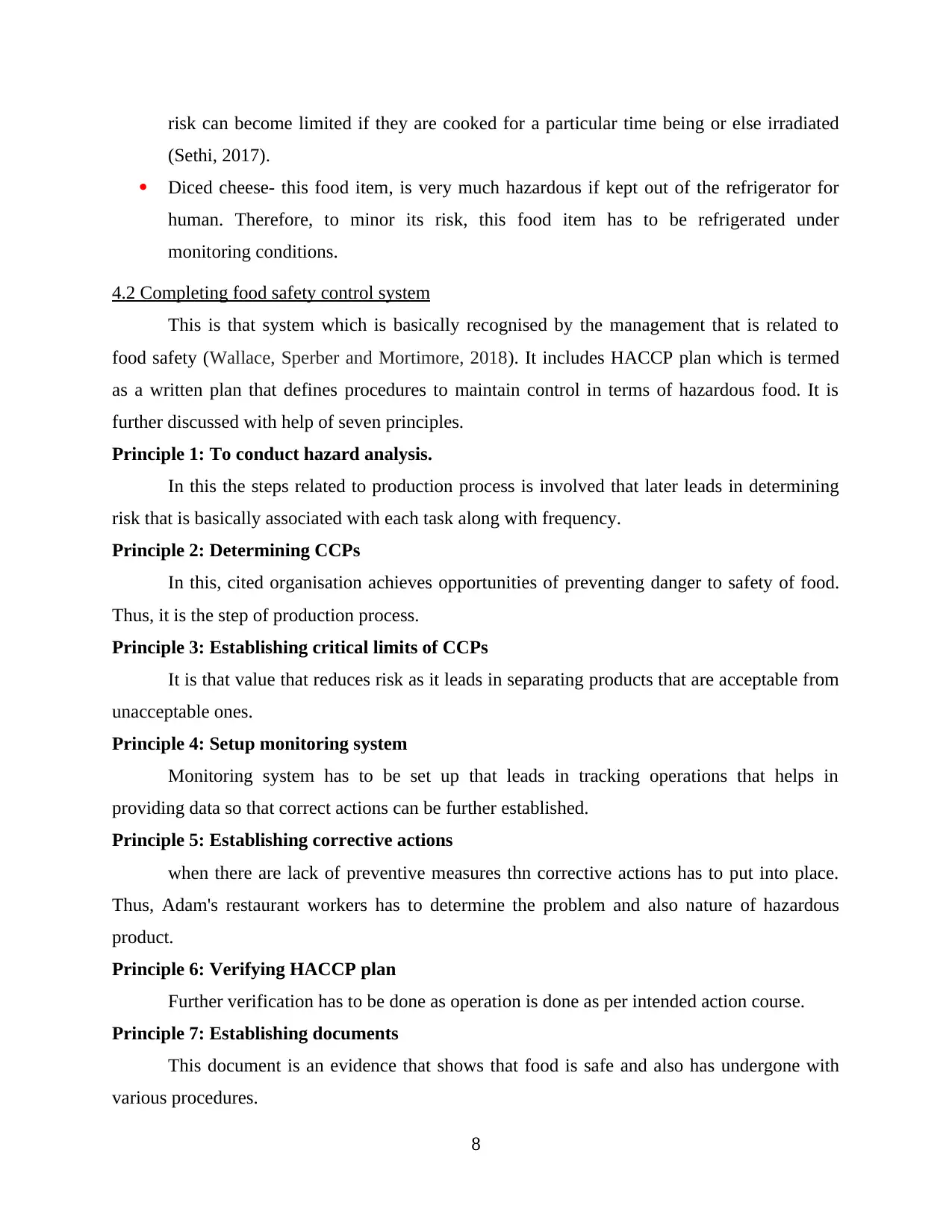
risk can become limited if they are cooked for a particular time being or else irradiated
(Sethi, 2017).
Diced cheese- this food item, is very much hazardous if kept out of the refrigerator for
human. Therefore, to minor its risk, this food item has to be refrigerated under
monitoring conditions.
4.2 Completing food safety control system
This is that system which is basically recognised by the management that is related to
food safety (Wallace, Sperber and Mortimore, 2018). It includes HACCP plan which is termed
as a written plan that defines procedures to maintain control in terms of hazardous food. It is
further discussed with help of seven principles.
Principle 1: To conduct hazard analysis.
In this the steps related to production process is involved that later leads in determining
risk that is basically associated with each task along with frequency.
Principle 2: Determining CCPs
In this, cited organisation achieves opportunities of preventing danger to safety of food.
Thus, it is the step of production process.
Principle 3: Establishing critical limits of CCPs
It is that value that reduces risk as it leads in separating products that are acceptable from
unacceptable ones.
Principle 4: Setup monitoring system
Monitoring system has to be set up that leads in tracking operations that helps in
providing data so that correct actions can be further established.
Principle 5: Establishing corrective actions
when there are lack of preventive measures thn corrective actions has to put into place.
Thus, Adam's restaurant workers has to determine the problem and also nature of hazardous
product.
Principle 6: Verifying HACCP plan
Further verification has to be done as operation is done as per intended action course.
Principle 7: Establishing documents
This document is an evidence that shows that food is safe and also has undergone with
various procedures.
8
(Sethi, 2017).
Diced cheese- this food item, is very much hazardous if kept out of the refrigerator for
human. Therefore, to minor its risk, this food item has to be refrigerated under
monitoring conditions.
4.2 Completing food safety control system
This is that system which is basically recognised by the management that is related to
food safety (Wallace, Sperber and Mortimore, 2018). It includes HACCP plan which is termed
as a written plan that defines procedures to maintain control in terms of hazardous food. It is
further discussed with help of seven principles.
Principle 1: To conduct hazard analysis.
In this the steps related to production process is involved that later leads in determining
risk that is basically associated with each task along with frequency.
Principle 2: Determining CCPs
In this, cited organisation achieves opportunities of preventing danger to safety of food.
Thus, it is the step of production process.
Principle 3: Establishing critical limits of CCPs
It is that value that reduces risk as it leads in separating products that are acceptable from
unacceptable ones.
Principle 4: Setup monitoring system
Monitoring system has to be set up that leads in tracking operations that helps in
providing data so that correct actions can be further established.
Principle 5: Establishing corrective actions
when there are lack of preventive measures thn corrective actions has to put into place.
Thus, Adam's restaurant workers has to determine the problem and also nature of hazardous
product.
Principle 6: Verifying HACCP plan
Further verification has to be done as operation is done as per intended action course.
Principle 7: Establishing documents
This document is an evidence that shows that food is safe and also has undergone with
various procedures.
8
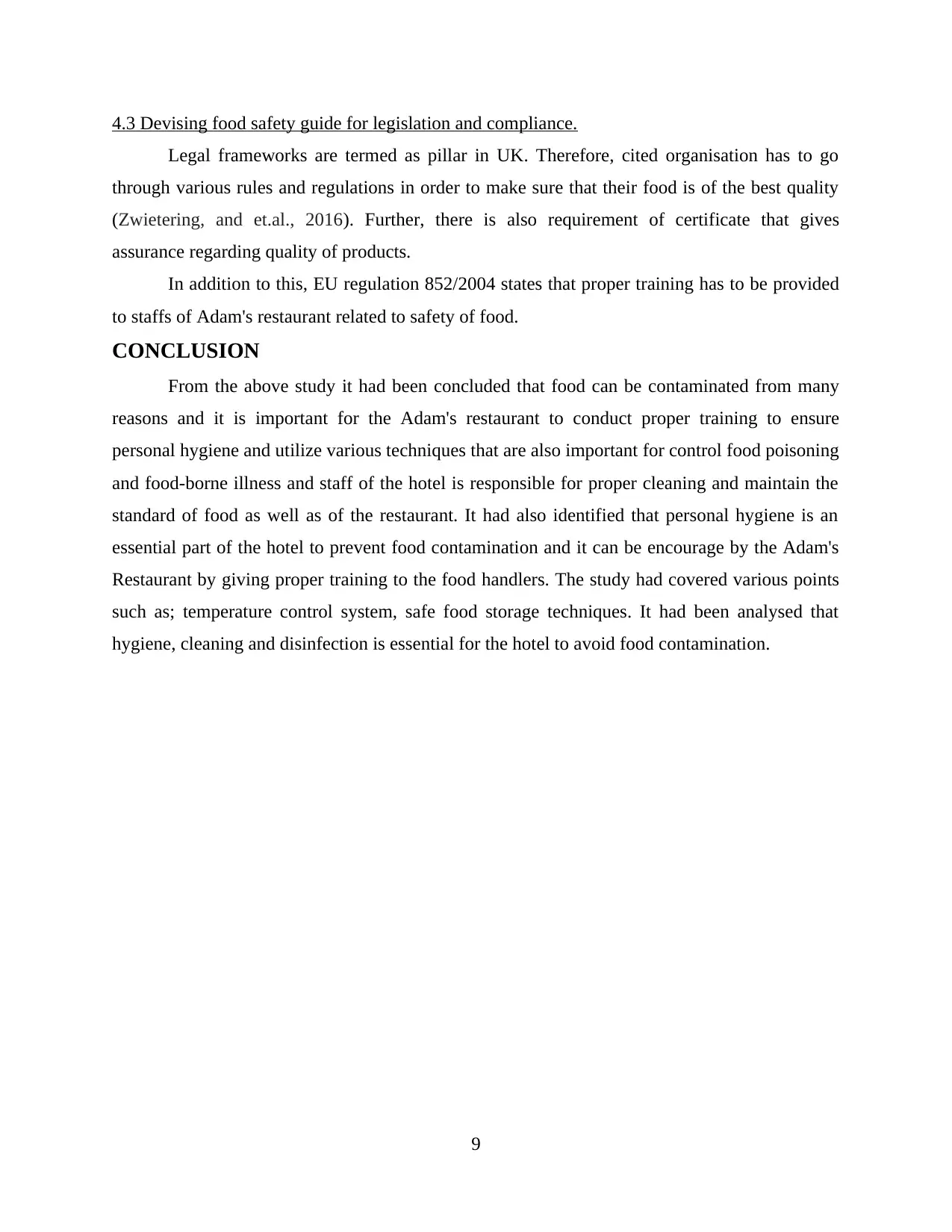
4.3 Devising food safety guide for legislation and compliance.
Legal frameworks are termed as pillar in UK. Therefore, cited organisation has to go
through various rules and regulations in order to make sure that their food is of the best quality
(Zwietering, and et.al., 2016). Further, there is also requirement of certificate that gives
assurance regarding quality of products.
In addition to this, EU regulation 852/2004 states that proper training has to be provided
to staffs of Adam's restaurant related to safety of food.
CONCLUSION
From the above study it had been concluded that food can be contaminated from many
reasons and it is important for the Adam's restaurant to conduct proper training to ensure
personal hygiene and utilize various techniques that are also important for control food poisoning
and food-borne illness and staff of the hotel is responsible for proper cleaning and maintain the
standard of food as well as of the restaurant. It had also identified that personal hygiene is an
essential part of the hotel to prevent food contamination and it can be encourage by the Adam's
Restaurant by giving proper training to the food handlers. The study had covered various points
such as; temperature control system, safe food storage techniques. It had been analysed that
hygiene, cleaning and disinfection is essential for the hotel to avoid food contamination.
9
Legal frameworks are termed as pillar in UK. Therefore, cited organisation has to go
through various rules and regulations in order to make sure that their food is of the best quality
(Zwietering, and et.al., 2016). Further, there is also requirement of certificate that gives
assurance regarding quality of products.
In addition to this, EU regulation 852/2004 states that proper training has to be provided
to staffs of Adam's restaurant related to safety of food.
CONCLUSION
From the above study it had been concluded that food can be contaminated from many
reasons and it is important for the Adam's restaurant to conduct proper training to ensure
personal hygiene and utilize various techniques that are also important for control food poisoning
and food-borne illness and staff of the hotel is responsible for proper cleaning and maintain the
standard of food as well as of the restaurant. It had also identified that personal hygiene is an
essential part of the hotel to prevent food contamination and it can be encourage by the Adam's
Restaurant by giving proper training to the food handlers. The study had covered various points
such as; temperature control system, safe food storage techniques. It had been analysed that
hygiene, cleaning and disinfection is essential for the hotel to avoid food contamination.
9
⊘ This is a preview!⊘
Do you want full access?
Subscribe today to unlock all pages.

Trusted by 1+ million students worldwide
1 out of 15
Related Documents
Your All-in-One AI-Powered Toolkit for Academic Success.
+13062052269
info@desklib.com
Available 24*7 on WhatsApp / Email
![[object Object]](/_next/static/media/star-bottom.7253800d.svg)
Unlock your academic potential
Copyright © 2020–2025 A2Z Services. All Rights Reserved. Developed and managed by ZUCOL.





